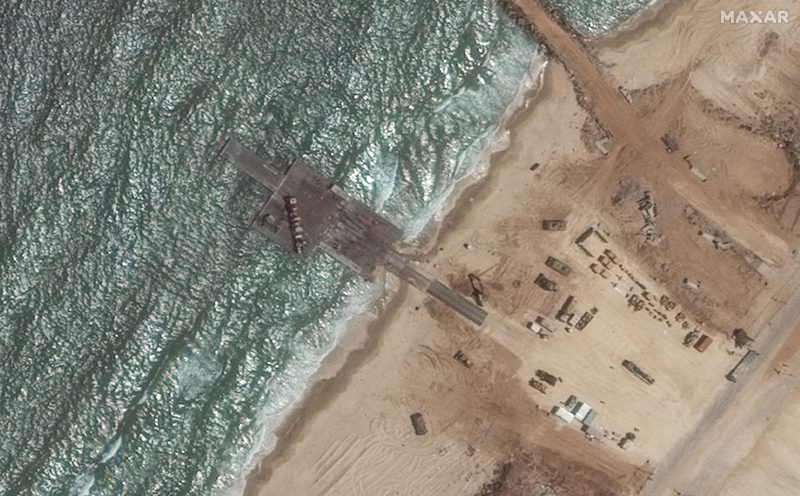Repeated mishaps with the Pentagon’s Gaza pier have triggered new scrutiny over whether it is safe and sensible to continue using the floating operation to bring humanitarian aid to starving Palestinians, with the Biden administration insisting it can salvage the mission and former military officials split on whether doing so is wise.
Deliveries over the pier were suspended Tuesday after it broke apart in rough water, with swells reaching upward of five feet, according to sea state trackers. It marked at least the third significant setback in a week; four U.S. Army vessels ran aground on Saturday, and a U.S. soldier was critically injured in an incident last week that the Pentagon has declined to detail.
Administration officials, who say it will take days to reassemble the pier, have acknowledged the difficulties but maintain the project is worth pursuing as part of a broader effort to help alleviate the dire food crisis.
“Why wouldn’t we try this?” National Security Council spokesman John Kirby said during a White House news briefing on Wednesday. “If we had this capability, and it was available to us, we have the know-how and the expertise to do it? Why would we leave that on the sidelines?”
President Biden announced the pier’s deployment in March, characterizing the effort as an emergency mission in which no U.S. service members would set foot in Gaza. A coterie of U.S. vessels and embarked personnel departed from southern Virginia days later, setting out on a weeks-long transit and targeting early May to have a floating structure operational — a timetable that slipped as rough seas roiled the Gaza coastline.
Its installation was completed May 16, and officials have said that about 1,000 tons of supplies made it to land before operations were halted. Pentagon officials have said that, after a ramping-up period, they expect to be able to deliver up to 2 million meals per day.
The concept — known in the Pentagon as Joint Logistics Over-the-Shore, or JLOTS — has been used by the military for decades, including in recent training exercises. But the pier system has long been limited to sea states of no more than three feet, according to several reports published in military journals. While efforts have been made to overcome that “enduring limitation,” more needs to be done, a 2019 assessment in the American Society of Naval Engineers says.
The Mediterranean Sea, especially in the east, is “notorious for sudden, vicious wind events,” said Jim Stavridis, a retired Navy admiral and NATO commander. Heavier anchoring could help, as could positioning large vessels to buffer the operation’s weak points from powerful waves, he said, “but in any maritime operation, sometimes the weather can defeat the best laid plans.”
Jerry Hendrix, a retired Navy captain, said he had been against the pier’s deployment because of the security vulnerabilities U.S. troops could face while operating it just outside a war zone. But the repeated problems with weather already have rendered the mission a “failed project,” he said, advocating for the administration to end it.
“Essentially all the winds come down the Med,” Hendrix said. “This is fairly all well known by mariners. This is a bad area of the Mediterranean to operate. So the idea of setting up a pier and dock structure? This was going to happen at some point in time.”
Gene Moran, a retired Navy captain, said a sense of urgency to relieve the humanitarian crisis was clear within the Biden administration and that, while assessments were probably done that took the weather into account, commanders appeared to decide they could start the mission during a period of choppy seas.
“They got that wrong,” said Moran, now a consultant in Washington.
U.S. troops involved in the project are trying their best, but the Biden administration’s reluctance to put American personnel on land has forced a reliance on Israeli forces who are unfamiliar with the pier system, Moran said.
The seas should calm soon, he added, saying that he believes the maritime operation should be part of an “all the above” approach that also includes continued airdrops and pressure from Washington to reopen overland routes so more aid can flow into the Palestinian enclave. Israeli leaders, citing security concerns, have sealed most crossings into Gaza, such as the one in Rafah bordering Egypt, creating bottlenecks for Palestinians on the brink of famine.
“I believe our number one ally in the Middle East should be taking our counsel,” Moran said. “They have created this circumstance, and they need to do more about it. This is a crisis of colossal proportions.”
Paul Kennedy, a retired Marine Corps general who oversaw multiple humanitarian operations, said he’s been left to wonder how well developed the military’s plans were to account for challenges like bad weather, accidents and enemy attacks.
“If the decision was made to go, then you’re supposed to go in a credible manner,” he said. “Your job as commander is to try to minimize all of that.”
A senior U.S. defense official, speaking on the condition of anonymity to discuss a sensitive issue, said that the pier operation was planned with history showing that this time of year generally has favorable sea conditions. The pier broke apart after a North African storm unexpectedly moved offshore, causing conditions to deteriorate quickly, the official said.
Joseph Votel, a retired Army general, said commanders need to “respect the sea,” but that the operation can still be viable.
“We have to continue to push this,” said Votel, who oversaw operations in the region as head of U.S. Central Command before retiring in 2019. “I think the situation requires it.”
The mission’s struggles, Votel said, present an opportunity for the administration to put greater pressure on Israel to open the land routes into Gaza. U.S. officials, he added, also could consider moving aid ashore using landing craft, a more conventional method.
“These are emergency situations that we’re trying to address,” Votel said, “and so the options are not going to be great.”

